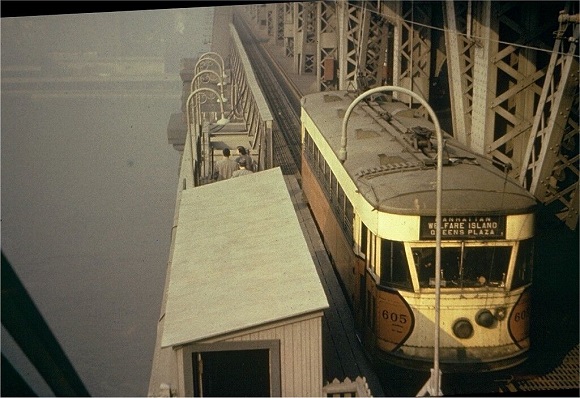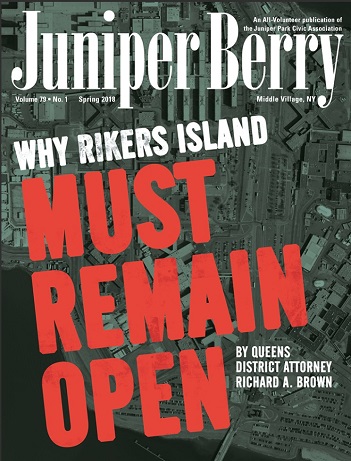Many a would-be king of the road crossing the Queensboro Bridge may observe a condo-dotted Roosevelt Island, unaware that this island, when it was less affluent, was the reason that a tiny bridge railway survived all other trolley lines in New York State.
The pre-Koch Queensboro Bridge, which opened in 1909, was designed primarily for mass transit use. The bridge had two upper level tracks for Second Avenue ͚el͛ use. There were four tracks for trolley car use: two were on the main roadway of the bridge, and the other two tracks were located on a shelf outside of the bridge girders. The two shelf tracks were restricted to trolley use only (bus rapid transit sans pollution).
Between 1909 and 1922, four separate companies, Third Avenue Railway, New York and Queens County Railway, Steinway Lines and Manhattan and Queens Traction used the bridge. This changed in 1922 when Third Avenue abandoned its Long Island City branch. New York and Queens County (later Queens Transit) separated from Steinway Lines (later Steinway Transit). New York and Queens County no longer used the bridge. With trolley use down to Steinway and M&Q on the bridge, only the two shelf tracks would be utilized after 1922.
Subway-elevated lines from Queensboro Plaza had reached Astoria and Flushing by 1930, with private bus operators (notably Triboro Coach in West Queens), providing feeder service to these subway-elevated lines. Trolleys were now less important. In 1937, Manhattan and Queens (later Green Lines) converted its long Queens Blvd route to South Jamaica, the Q60, over to buses. Steinway Lines, the final Queensboro Bridge trolley operator, converted to Steinway Transit buses in 1939. However, there was one problem: buses could not serve the hospital on Welfare (later Roosevelt) Island in the middle of the East River. The trolleys stopped at a small station with an elevator at the northern side of the bridge, which took people and vehicles down to street level. There was also a smaller stop on the bridge at Vernon Blvd in Long Island City for pedestrians only.
Enter the Queensboro Bridge Railway
A 1.64-mile segment of track over the Queensboro Bridge to serve Welfare Island was retained. A subsidiary company of Steinway Transit was formed and named Queensboro Bridge Railway. To operate the newly formed bridge railway hand-me-down streetcars from former Steinway lines were used. These cars were replaced in 1949 by newer (built in 1930), ͞600 series Electroliners͟ from Union Street railway of New Bedford, Mass. These cars served until the end of bridge trolley operation.
The bridge cars were maintained in the Third Avenue Railway shop at Third Avenue at 67th Street in Manhattan via a track connection at 59th Street and Second Avenue, until Third Avenue motorized its Manhattan lines in 1947. Thereafter all maintenance was done over a pit at the Manhattan terminal under the approach to the Queensboro Bridge at 59th Street and Second Avenue. The trolleys were repainted in the orange and cream scheme of parent Steinway Transit. Now isolated from other street railways, and with the opening in 1953 of a new bridge directly connecting Long Island City with Welfare Island, the bridge trolleys appeared to be dinosaurs from a Jurassic transit age. They would soon be extinct.
Final Days
I had completed high school in 1955 and was determined to ride this tiny bridge railway while there was still time. At the dimly lit underground Manhattan Railway Terminal, I boarded #GO2 – stained and dented from many years of public service. Soon I was on the bridge shelf where I enjoyed a beautiful view of the Manhattan skyline. That thrill was not to be experienced by many more after that. On April 7, 1957, the Queensboro Bridge Railway ceased. Thus have the tides of change swept out the last trolley line in New York State.
Today, sealed in an abandoned railway terminal are reminders that before an upscale Roosevelt Island was served by 63rd Street tunnel service, the island was well served by a more leisurely form of transportation when automobiles were few and the trolley car was king of the road.
Information for this story was derived from the late Vincent F. Seyfried’s writings and other railfan publications as well as my own personal memories as a railfan.




